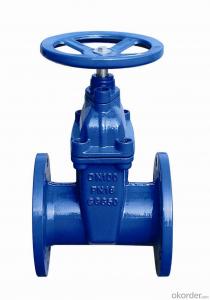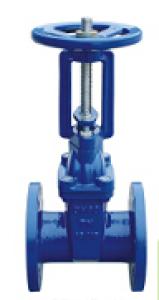Valve DN80 Non-rising Resilient Sluice BS5163
- Loading Port:
- Tianjin
- Payment Terms:
- TT OR LC
- Min Order Qty:
- 1 set
- Supply Capability:
- 1000 set/month
OKorder Service Pledge
OKorder Financial Service
You Might Also Like
1.Structure of Gate Valve Description:
A gate valve, also known as a sluice valve, is a valve that opens by lifting a round or rectangular gate/wedge out of the path of the fluid. The distinct feature of a gate valve is the sealing surfaces between the gate and seats are planar, so gate valves are often used when a straight-line flow of fluid and minimum restriction is desired. The gate faces can form a wedge shape or they can be parallel. Gate valves are primarily used to permit or prevent the flow of liquids, but typical gate valves shouldn't be used for regulating flow, unless they are specifically designed for that purpose. Because of their ability to cut through liquids, gate valves are often used in the petroleum industry. For extremely thick fluids, a specialty valve often known as a knife valve is used to cut through the liquid. On opening the gate valve, the flow path is enlarged in a highly nonlinear manner with respect to percent of opening. This means that flow rate does not change evenly with stem travel. Also, a partially open gate disk tends to vibrate from the fluid flow. Most of the flow change occurs near shutoff with a relatively high fluid velocity causing disk and seat wear and eventual leakage if used to regulate flow. Typical gate valves are designed to be fully opened or closed.When fully open, the typical gate valve has no obstruction in the flow path, resulting in very low friction loss.
2. Main Features of the Gate Valve:
• Valve body cavity using non-toxic epoxy resin,both inside and outside flashboard completely is coated with rubber
• Free of water pollution
• High manufacturing accuracy
• High strength
• Environmental protection and energy saving
• Good visual effect
3. Images


4.FAQ
1. What's are the characteristics of gate valve?
The distinct feature of a gate valve is the sealing surfaces between the gate and seats are planar, so gate valves are often used when a straight-line flow of fluid and minimum restriction is desired. The gate faces can form a wedge shape or they can be parallel.
2. What is the work principle of gate valve ?
The gate faces can form a wedge shape or they can be parallel. Gate valves are primarily used to permit or prevent the flow of liquids, but typical gate valves shouldn't be used for regulating flow, unless they are specifically designed for that purpose. Because of their ability to cut through liquids, gate valves are often used in the petroleum industry.
3. What is the structure?
Bonnets provide leakproof closure for the valve body. Gate valves may have a screw-in, union, or bolted bonnet. Screw-in bonnet is the simplest, offering a durable, pressure-tight seal. Union bonnet is suitable for applications requiring frequent inspection and cleaning. It also gives the body added strength. Bolted bonnet is used for larger valves and higher pressure applications.
- Q: What is the International Standard or other acceptable calculation or table for determine the air supply of pneumatic actuator in shutdown valve 6 to 24.Desired answer will be air flow in SCFM.Thank you.
- Shut down valves I've worked with haven't had an 'Air Flow' for their operation. For the smaller valves, they consist of diaphragm operated valves either held open or closed by pneumatic pressure. The air supply at 25psi to give a diaphragm holding pressure of 15 psi, is via a solenoid valve which dumps the air pressure to either open or close the valve depending upon its function. (That of isolating a system or relieving pressure). The solenoid is actuated by a signal from the shut-down system, and the valve is a 3-way unit which isolates the supply air and vents the pressure off the diaphragm. Other SDV's in my experience, are operated in a similar way but are much larger and are operated by a pneumatic air cylinder and piston with air supplied at 100 psi. Others encountered are ... MOV's...Motor Operated Valves that can be automatically operated from the shutdown system, or Operated Remotely from a safe distance (ROV's).
- Q: Is there a more technically correct name for a valve that slowly opens, allowing increased pressure in a water line without blowing the end off?
- I've always known them to be simply called motorized valves, but they aren't specifically made to prevent instantaneous pressure build up. They are usually installed as a convenience type of thing and in lieu of solenoid valve which WOULD be an almost immediate full pressure situation, but any valve other than a solenoid activated one will allow for slow build up of pressure. A motorized valve just lets you do it automatically and you don't have to be right at the valve location to open it. Al
- Q: I have 3 such valves in the line and none seem to be able to move past 10/4 oclock position and water remains on. Is there a way to adjust valve? Seems there is slot for screwdriver in center of valve.
- The threads are stripped, you will have to get a new one, until then shut off main line into house if you are flooding
- Q: where can i get my Idle air control valve cleaned on a 84 celica supra
- There should be a VECI map under your hood that shows you where this valve is located. In a pinch, find a Haynes manual or a Robert Bentley manual that has pictures in it. If you can find the valve, you can clean it yourself with a can of spray Gum-out. While you're at it, clean the throttle body and PCV valve, too. Hopefully, you have had the good sense to have used only genuine Toyota coolant in this car, since Toyota heads require a special coolant formulation to prevent aluminum deterioration. More older Japanese engines are ruined with improper coolant than I can write about here. Sensor damage is caused as well! You might take your car to the Toyota dealer and ask them to clean out the valve for you. Since this is only a 2 minute job, they just might do it for free. If they do, at least offer to tip the technician under the table. Be sure to power wash your entire engine bay before you take the car in. They will LOVE you for this!!!
- Q: When i disconnected my Diverter Valve and made it non-recirculating i drove down the street and my engine cut out on me. it will go a few feet and after the excess pressure is released (PSHH) the car cuts out. i reconnected the valve tubing making it rec-circulating and it works fine. im baffled i know VW is supposed to run a DV but last night i saw a stock VW GOLF running blow off and he was stock. any ideas? it is an after market DV made by forge.
- The OEM valve has a very low spring rate against the diaphragm holding the plunger down. The very first time you released the throttle the engine vacuum easily held the valve open. When not in boost the open valve will become an intake leak because its bypassing the MAF (mass air flow) sensor. If the MAF reads very low air coming in through the it, the ecm will start lowering the injector pulse width until it cant compensate any longer and will cut off because of the air leak. The Golf was running a higher spring rate to keep the valve closed at idle or has a chipped ecu to be able to release to atmosphere. Hope this helped out.
- Q: sprinkler valve leaking
- Most valves are either 3/4 or 1 with female connections. Use the same size male adaptors with teflon tape wraped around the threads and screw it into the valves. Take a photo before you start to refer to when rewiring.
- Q: I need an angle valve for my sink buts its a bit of an odd size. I have copper tubing at 1/2 i need a valve preferably compression that can feed to a water supply that is 1/2 Pipe thread.Included images of the supply hose valve to sink. To help show what i'm looking for.
- If you're looking for a valve that attaches to a 1/2 iron pipe coming out of the wall, and then will feed to 1/2 copper tubing, then you're looking for- an angle stop, 1/2 female iron pipe to 1/2 compression. Just about any good hardware store will have it in stock or be able to order it, just be sure that they know what you need. I've often found that using visual aids,like a piece of pipe in one hand, and a piece of tubing in the other, with an empty space, waiting for a valve, between them, can be an invaluable aid to communication. Don't even try to cut and adapt a braided hose. The stainless braid contains a (relatively thin) rubber hose. Without the braid to reinforce it, it will burst. If you need to adapt plumbing, there is always a way to get water from point A to point B. The challenge is finding the most elegant route.
- Q: What is the primary function of valve seals?
- A 'leak-down' test is the best bet, indicates the place in the process the compression is leaking and if it's across the valve stems than for definite the seals need replacing. Are not able to judge it via the smoke correctly as oil would be slipping previous the rings also.
- Q: how to replace a valve cover gasket on a 98 pontiac sunfire 2.2. engine?
- First off, you remove the PCV hose and unscrew the plastic nut that retains the PCV valve. Next you remove the air intake tube from the throttle body and the air intake housing. Now locate the bracket on the side of the throttle body that contains the throttle cable. Remove the 2 bolts from this bracket and remove the cables from the throttle body. You should now be able to remove the valve cover from any obstructions. If you are not cleaning the valve cover, there is no need to remove the PCV valve. If you are cleaning it with soap and water, take the PCV out. The gasket is one piece and rubber, but you may find it a pain to keep the gasket in the groove on the valve cover, so you might try some yellow weatherstrip sealer to help hold the gasket in place. Let it dry for a little while before reinstalling the valve cover, so the gasket doesn't 'roll' out of the groove on the corners, or it will leak heavily. Good luck.
- Q: Hey, ive got a scooby and have a baileys dump valve that is a loud deep wooooosh sorta sound. What dump valve does the more high pitch sound? also they dump valve with the higher pitch seems to need less presure ta dump, mine needs alot of pressure before it will dump loud?
- if i remember rite you can adjust the control settings for your dump valve so that it will dump at a lower pressure and a lower pressure dump should also give you the sound that you are looking for.
Send your message to us
Valve DN80 Non-rising Resilient Sluice BS5163
- Loading Port:
- Tianjin
- Payment Terms:
- TT OR LC
- Min Order Qty:
- 1 set
- Supply Capability:
- 1000 set/month
OKorder Service Pledge
OKorder Financial Service
Similar products
Hot products
Hot Searches
Related keywords






























